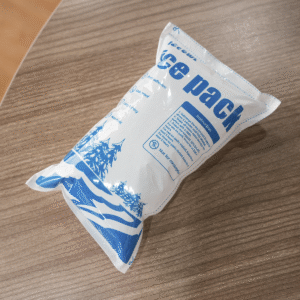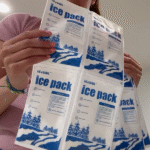Garantizar la eficacia de las vacunas durante el transporte es fundamental, ya que incluso ligeras fluctuaciones de temperatura pueden comprometer su eficacia. Las bolsas de hielo seco son una herramienta esencial en la logística de la cadena de frío de las vacunas sensibles a la temperatura. Estos paquetes garantizan que las vacunas permanezcan dentro del rango de temperatura requerido durante el transporte., preservando su potencia y seguridad. En este artículo, we will explore the role of Bolsas de hielo seco en el transporte de vacunas., sus beneficios, y las mejores prácticas para utilizarlos en 2025.
-
¿Qué son las bolsas de hielo seco?, y cómo funcionan para el transporte de vacunas?
-
¿Cuáles son los beneficios de usar hielo seco sobre otros métodos de enfriamiento para el envío de vacunas??
-
¿Cómo garantizan las empresas la seguridad y el cumplimiento cuando utilizan bolsas de hielo seco en el transporte de vacunas??
-
¿Cuáles son las últimas tendencias e innovaciones en el uso de hielo seco para la logística de la cadena de frío??
¿Qué son las bolsas de hielo seco?, y cómo funcionan para el transporte de vacunas?
El hielo seco es la forma sólida de dióxido de carbono, and it sublimates directly from a solid to a gas at a temperature of -78.5°C (-109.3°F). This unique property allows dry ice packs to maintain extremely low temperatures, which is crucial for transporting vaccines that require storage at ultra-low temperatures. A diferencia del hielo convencional, which melts and can cause water contamination, El hielo seco no deja residuos., making it ideal for maintaining the cold chain during vaccine transport.
When placed in insulated containers, dry ice absorbs heat from the surrounding environment, creating a consistent and cold atmosphere to protect temperature-sensitive vaccines. The slow sublimation process ensures that vaccines remain within the critical temperature range for extended periods, whether during domestic or international shipments.
How Do Dry Ice Packs Maintain Consistent Temperature During Transport?
El hielo seco se sublima lentamente, releasing cold gas that absorbs heat from the surrounding air. This process maintains a steady temperature environment, making it highly effective for keeping vaccines below freezing. Depending on the amount of dry ice used, temperatures can be maintained for up to 72 horas o más.
| Método de control de temperatura | Periodo de tiempo | Eficacia | Aplicación práctica |
|---|---|---|---|
| Hielo seco | 24-72 horas | Altamente efectivo | Long-haul vaccine transport |
| Paquetes de gel | 12-24 horas | Moderado | Envíos de corta distancia |
| Paquetes de hielo | Varía | Bajo a moderado | Suitable for non-temperature-sensitive products |
Real-Life Examples of Dry Ice Packs in Vaccine Transport
-
Guión 1: A healthcare provider uses dry ice to transport vaccines to rural areas, ensuring that the vaccines remain viable even with limited access to refrigeration.
-
Guión 2: An international logistics company specializing in pharmaceutical shipments uses dry ice to maintain the cold chain for global vaccine distribution.
Caso de la vida real: A logistics provider in Europe successfully transported COVID-19 vaccines using dry ice packs, ensuring that vaccines remained within the required temperature range throughout the long international journey, con un 100% success rate in preserving their efficacy.
What Are the Benefits of Using Dry Ice for Vaccine Shipping?
Beneficios clave
-
Effective Long-Term Cooling: Dry ice can maintain ultra-low temperatures for an extended period, which is essential for vaccines that require freezing conditions, como las vacunas de ARNm.
-
No tóxico y seguro: A diferencia de los paquetes de gel, dry ice does not leave any liquid residue that could damage vaccines or packaging. Se sublima directamente en gas., reducing the risk of contamination.
-
Versatile Shipping: Dry ice is adaptable for small-scale and large-scale shipments, and the amount used can be adjusted depending on the specific needs of the vaccine.
Ventajas adicionales
-
Rentabilidad: Although the initial cost may be higher than some cooling methods, the use of dry ice can reduce losses due to spoilage, leading to long-term savings.
-
Reduced Spoilage and Losses: Manteniendo temperaturas constantes, dry ice helps to ensure that vaccines reach their destination without compromising quality.
Consideraciones de seguridad al manipular hielo seco
Handling dry ice requires careful attention due to its extremely cold temperature and the risk of CO₂ buildup. The following safety precautions should be observed when using dry ice for vaccine transport:
-
Ventilación: Ensure that all containers are vented to release CO₂ gas to prevent pressure buildup that could cause rupture.
-
Equipo de protección: Personnel should wear insulated gloves and safety goggles when handling dry ice to prevent frostbite and eye injury.
-
Almacenamiento adecuado: El hielo seco nunca debe almacenarse en un recipiente hermético.. Always store it in a well-ventilated area.
How Dry Ice Packs Compare to Other Cooling Methods
Dry ice is the best solution for vaccines requiring deep-freeze conditions, como las vacunas de ARNm. Sin embargo, for vaccines that only need refrigeration (2-8°C), paquetes de gel o materiales de cambio de fase (PCM) are suitable alternatives. Aquí hay una comparación rápida:
| Método de enfriamiento | Rango de temperatura | Duración del enfriamiento | Consideraciones regulatorias |
|---|---|---|---|
| Hielo seco | -78.5°C | Arriba a 72 horas | Classified as hazardous material; requires IATA and CFR compliance |
| Paquetes de gel | 2-8°C | Arriba a 24 horas | No special hazardous classification |
| PCM | 2-8°C, -20°C, or custom ranges | Varies based on PCM type | Can be used for non-ultracold vaccines |
Latest Trends and Innovations in Dry Ice Usage for Vaccine Transport
Producción de hielo seco sostenible
En 2025, dry ice production is becoming more sustainable, with innovations like carbon capture methods helping to reduce environmental impacts. Companies are exploring more eco-friendly production methods to meet the increasing demand for cold chain logistics.
Monitoreo de temperatura en tiempo real
With the growing importance of precise temperature control, real-time monitoring technology has become a critical part of vaccine transport. IoT-enabled sensors are now being used to continuously track the temperature of vaccine shipments, ensuring that they stay within the required range.
Frequently Asked Questions About Dry Ice and Vaccine Transport
q: How long do dry ice packs last for vaccine transport?
A: Dry ice packs typically maintain their cooling power for 24-72 horas, depending on the quantity of dry ice and the quality of insulation used.
q: Es seguro de hielo seco para manejar?
A: While dry ice is safe with proper precautions, it must be handled with care. Always use gloves and ensure that storage areas are well-ventilated to prevent CO₂ buildup.
Conclusión y recomendaciones
En resumen, dry ice packs are essential for transporting vaccines that require ultra-low temperatures. Their ability to maintain consistent and cold temperatures for extended periods makes them indispensable in the cold chain logistics industry. Businesses involved in vaccine transport should invest in dry ice solutions to reduce spoilage, ensure compliance with regulations, and improve the reliability of their shipping processes.
Siguientes pasos
To optimize your vaccine transport processes, start by evaluating your current cold chain logistics. Consider working with a logistics provider that specializes in dry ice and other cold chain solutions to ensure the safe and effective delivery of vaccines.
Acerca de Tempk
Tempk is a leading provider of advanced cold chain solutions, specializing in dry ice packs and insulated shipping containers for the transportation of pharmaceuticals and biologics. We are committed to providing safe, eficiente, and environmentally responsible solutions that help businesses meet their cold chain logistics needs.
Contact us today for expert advice on optimizing your vaccine transport logistics!
























